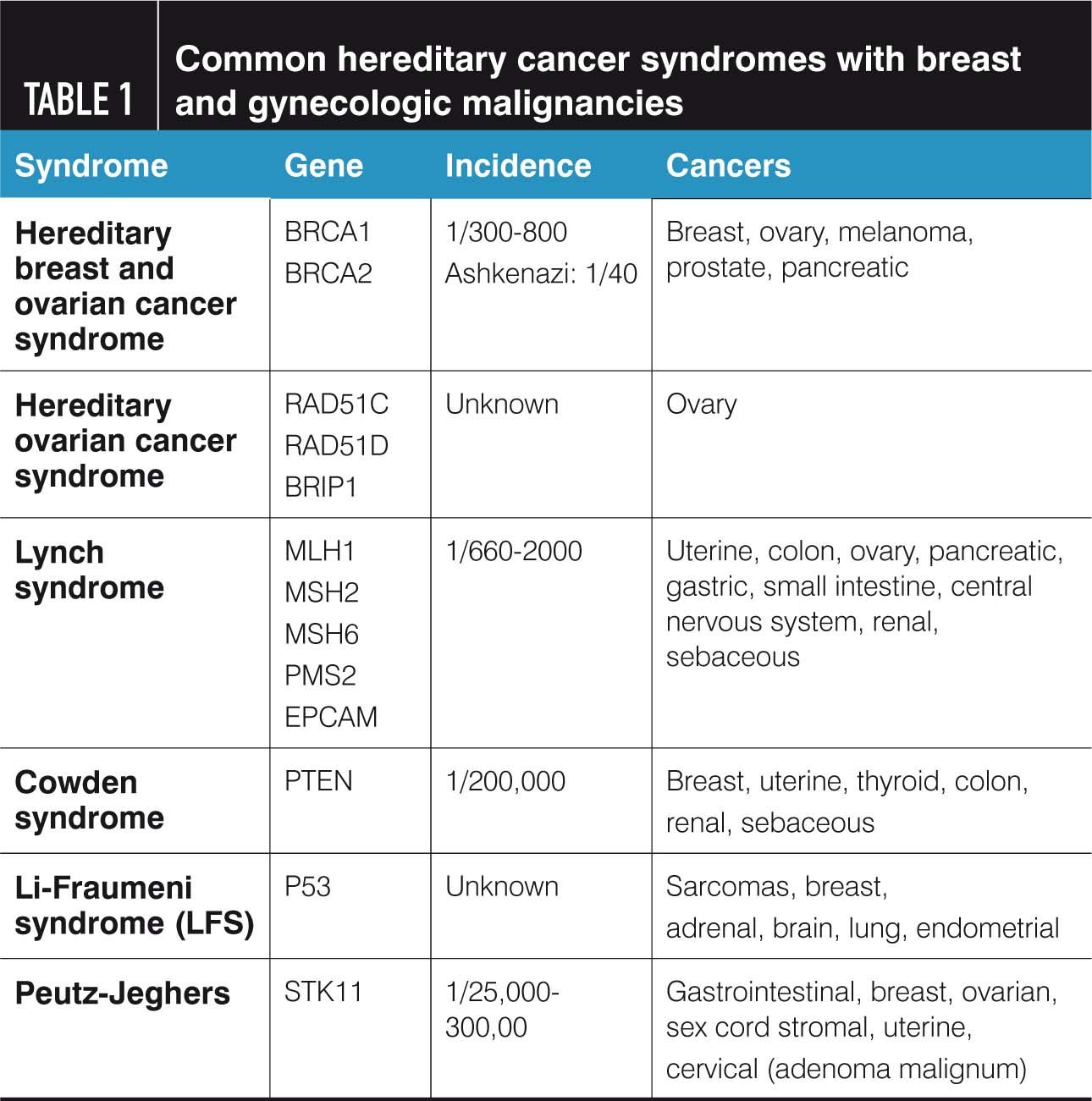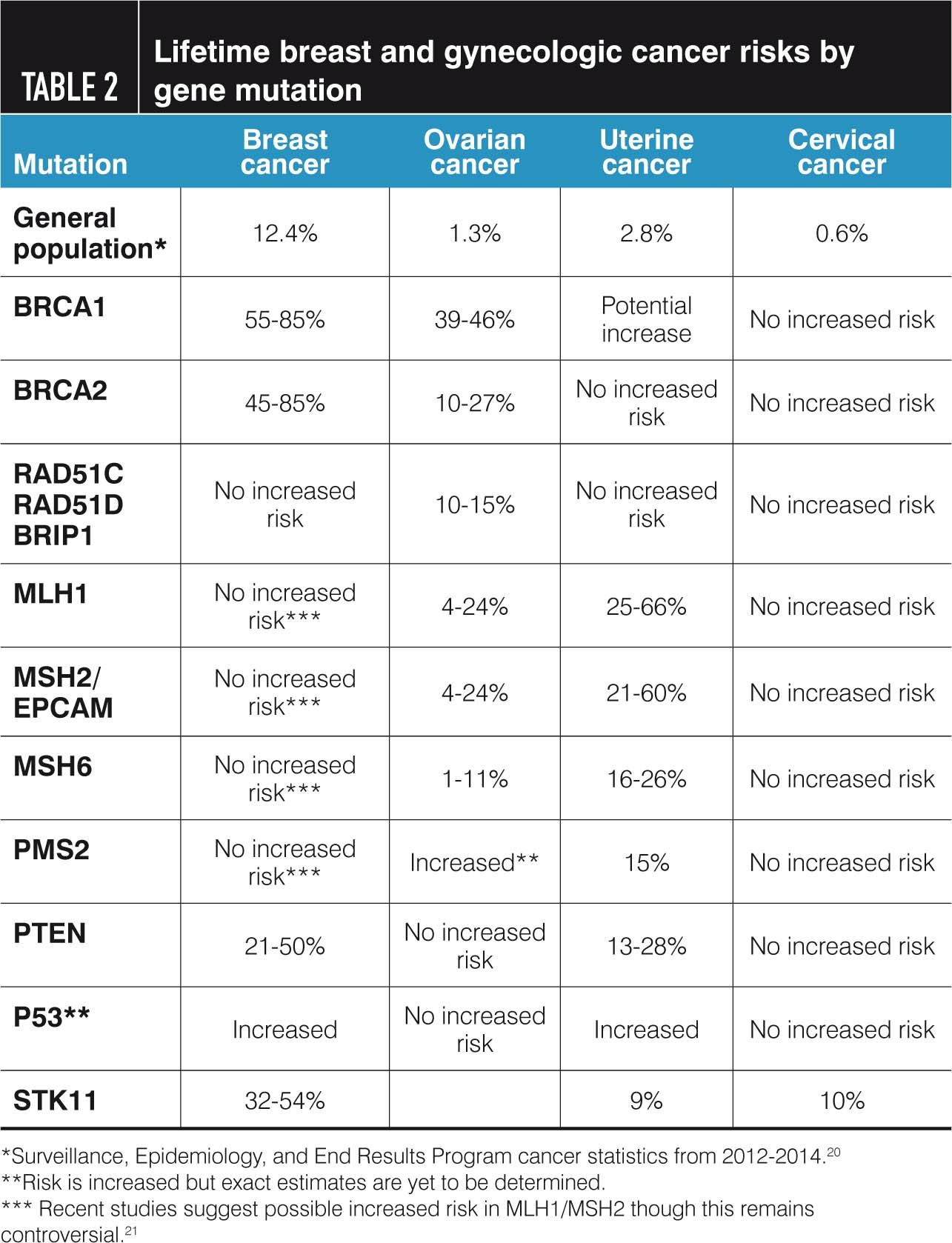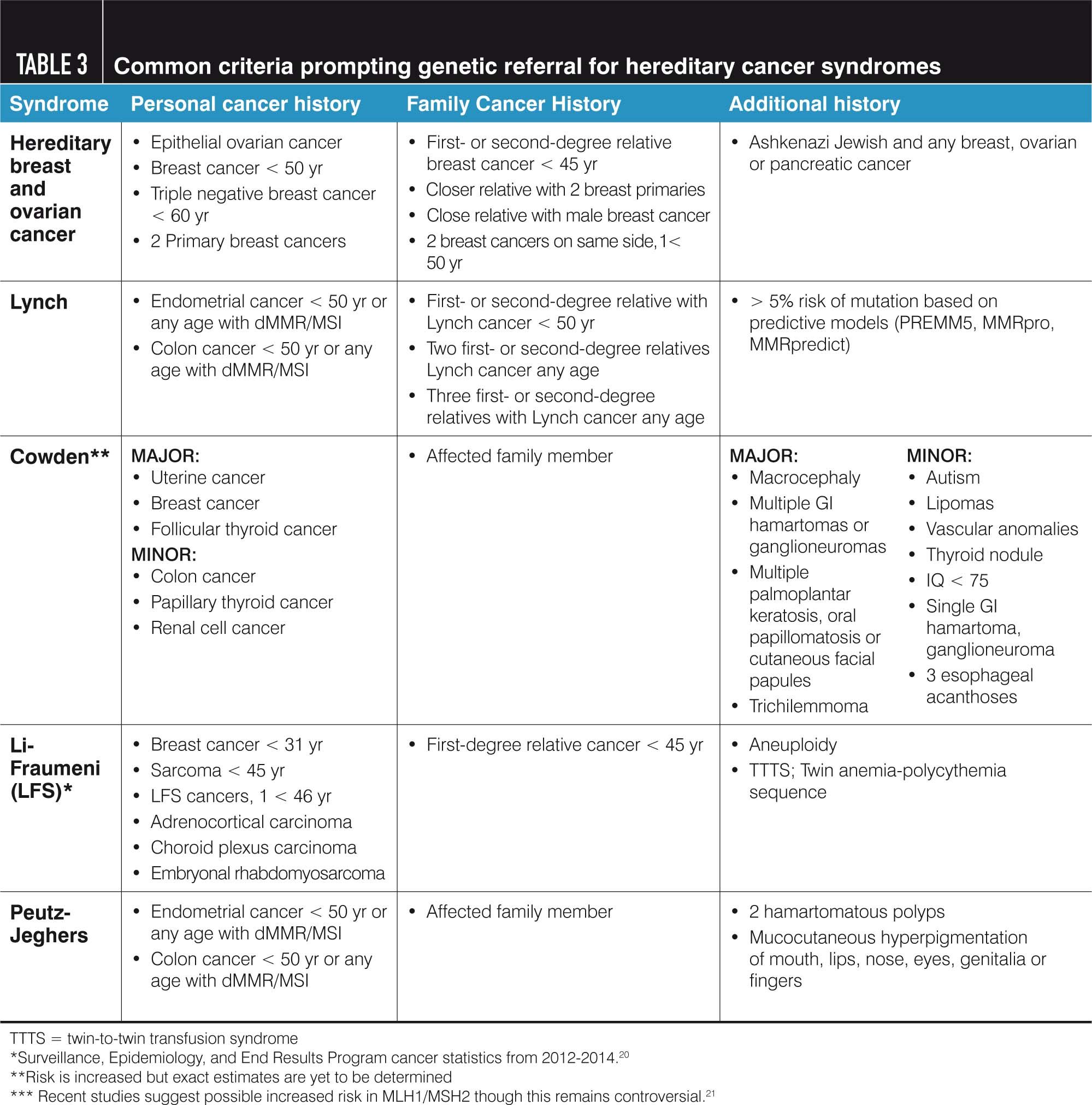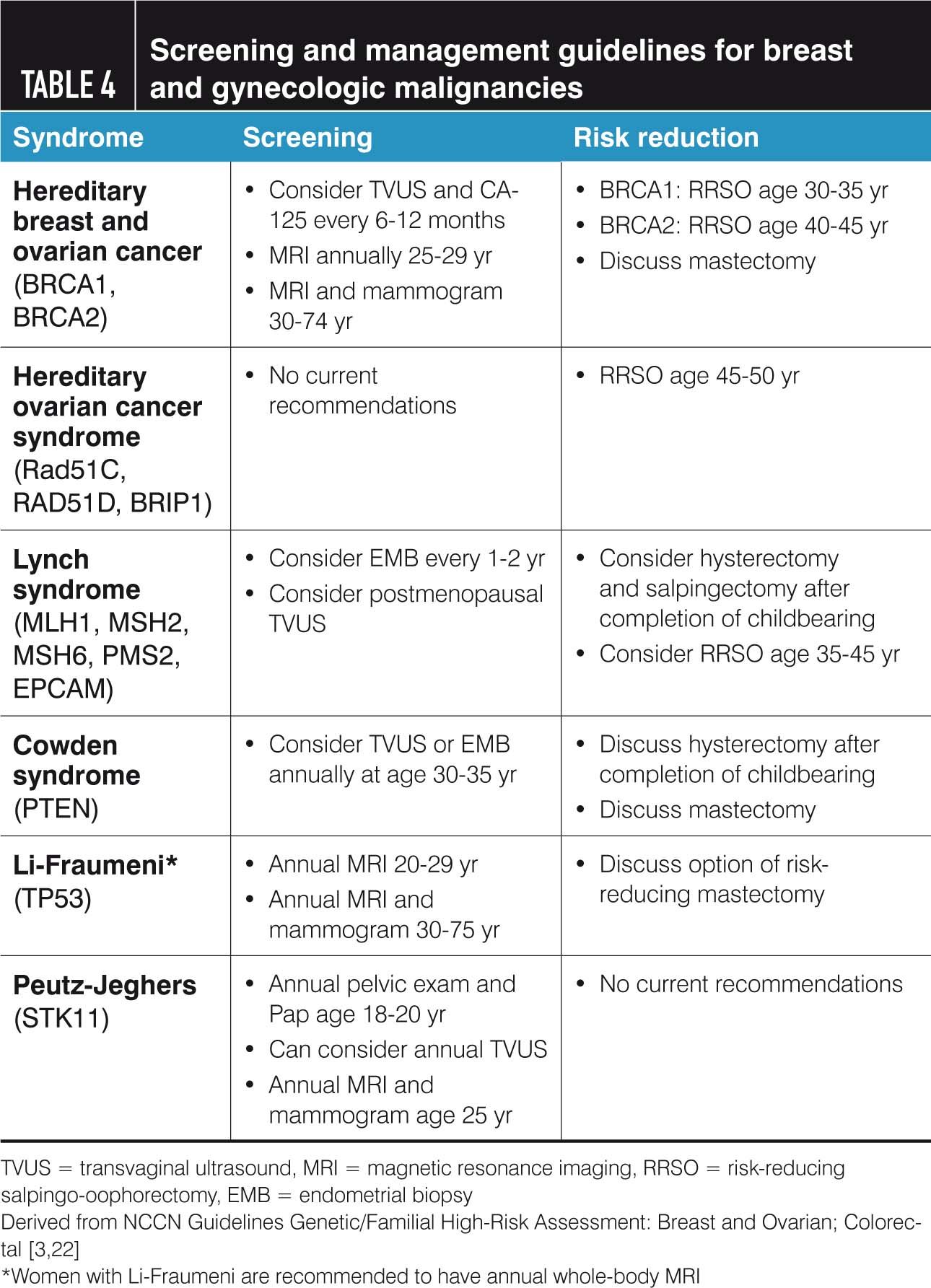Hereditary cancers in gynecology: What clinicians need to know
The contribution of hereditary cancer syndromes to many gynecologic malignancies has been increasingly recognized over the past decade. As they often serve as primary care providers, ob/gyns are uniquely positioned to help identify at-risk women before they develop cancer.

Introduction
The contribution of hereditary cancer syndromes to many gynecologic malignancies has been increasingly recognized over the past decade. As they often serve as primary care providers, ob/gyns are uniquely positioned to help identify at-risk women before they develop cancer. Identification of these women is important so they may be offered increased screening or risk-reduction measures that have proven benefits for improving survival. The most common syndromes related to breast and gynecologic cancers are highlighted in Table 1.

Though most cancers are sporadic, women with a known deleterious genetic mutation have significantly increased risks of developing a malignancy (Table 2). Of gynecologic cancers, ovarian cancer is most often associated with an inherited susceptibility gene, which can occur in about 20% of cases. The majority of hereditary breast and ovarian cancers are due to BRCA mutations; however, a significant portion are related to several other gene mutations (RAD51C, RAD51D, BRIP1, Lynch genes).1 In contrast, only 4% to 5% of non-hereditary breast cancers are related to BRCA1 and 2, with an even lower percentage due to other genes (PTEN, TP53, PALB-2, CDH, STK-11).2 Similarly, very few endometrial cancers are hereditary with about 3% to 5% associated with Lynch syndrome and some are even more rarely related to Cowden’s syndrome (PTEN), Li-Fraumeni (TP53), or Peutz-Jeghers (STK11).2 All of these cancer syndromes are autosomal-dominant and have implications not only for a patient, but also for her family.2
Identification of high-risk women and genetic testing
There are several features in a woman’s personal or family history that should raise suspicion for potential involvement of an underlying genetic mutation and prompt genetic counseling/testing (Table 3). Most cancer syndromes will affect multiple generations, and diagnoses will occur at an earlier age than in sporadic malignancies. Male and triple-negative breast cancers (negative for estrogen, progesterone receptors and HER2/neu amplification) are also hallmarks of hereditary cancers, as is having a relative affected by 2 primary malignancies.2 In addition, any woman who has a close relative with a known cancer-susceptibility gene mutation should be referred for testing.3
When possible, genetic testing in a family should start with a cancer-affected individual. The affected person is the most likely in the family to carry a mutation and from whom a negative result is most informative-meaning, that if full genetic testing is negative, there is no identifiable mutation as the cause of the cancer and thus no benefit to testing cancer-unaffected individuals within that same familial lineage. But if a deleterious mutation is found in the person with cancer, directed genetic testing can then be initiated in other family members to determine if they carry the gene (true positives who need further tailored screening and risk reduction measures) or they do not (true negatives who can likely go back to population cancer screening). If the cancer-affected relative is not available, the closest relation to the affected family member is the next best option.

In 2014, the Society of Gynecologic Oncology recommended genetic testing for all women with epithelial ovarian cancer.4 As more women are undergoing testing and technology has evolved to make testing cheaper and faster, more and more cancer susceptibility genes are being identified. This has contributed to increasing the utilization of gene panel testing.1 While testing upwards of 20 to 50 genes may increase the likelihood of finding a deleterious mutation, it also leads to discovery of more uncertain results, such as variants of uncertain significance (VUS) or deleterious genes with moderate risk or penetrance, for which there is far less data on which to base management decisions. A VUS is a change in the gene that has not yet been associated with causing a cancer, most often because there is not yet enough information about the specific variant to determine if it is benign versus cancer-causing. Most of these mutations are reclassified as benign when more data become available over time.
Interpreting these test results has important implications. For women with known mutations in well-described cancer genes, evidence-based screening and risk reduction strategies are described below. However, care must be taken not to apply the same guidelines to women found to have a VUS, as that does not imply increased cancer risk; it is simply a variation whose significance remains unclear.5 In addition, women with a VUS or an entirely negative genetic result may remain at significantly increased cancer risk as current testing doesn’t eliminate the possibilities of increased familial cancer risk because causative mutations exist that have yet to be discovered. Management of these potentially high-risk women should be individualized with the aid of a genetic counselor or a provider with experience in hereditary cancer syndromes as they may still benefit from more intensive screening/risk reduction measures even in the face of negative genetic testing results.
NEXT: Screening
Screening
The benefit of increased screening in women with hereditary cancer syndromes is best established for breast cancer. More frequent screening with mammography and the addition of breast magnetic resonance imaging (MRI) does detect earlier cancers in women at high risk of breast cancer.6 The benefit of early detection also translates into improved survival for these women.7 In contrast, screening for ovarian cancer with ultrasound and CA-125 has never been shown to improve early detection or survival.8,9 The same is true for endometrial cancer, but screening can be performed at the discretion of the physician following National Comprehensive Cancer Network (NCCN) guidelines for women who have not yet undergone risk-reducing surgery.

For women with a genetic predisposition to breast cancer, screening begins from age 20 to 25 typically with MRI (mammograms are omitted prior to age 30 in women with BRCA mutations), with slight variation based on the specific gene3 (Table 4). MRI is often used in younger women to reduce lifetime radiation exposure and idiopathic cancers. There are no recommendations for more intensive MRI screening after age 75, and its use should be individualized.3
Despite lack of evidence for ovarian cancer screening, in women who have not yet undergone oophorectomy and are at high-risk the NCCN recommends consideration of annual transvaginal ultrasound (TVUS) and CA-125.3 Women should be counseled regarding the extreme limitations of current ovarian cancer screening. Likewise, screening with TVUS and endometrial biopsy every 1 to 2 years can be considered for patients at high risk of uterine cancer, although data supporting this recommendation are limited and many simply recommend prompt evaluation of any irregular bleeding.3
Risk reduction
Even before women are ready to undergo a risk-reducing surgery, there are ways they can reduce their cancer risk through the use of medications, primarily birth control pills for ovarian cancer risk reduction and selective estrogen-receptor modulators (SERMs) for breast cancer risk reduction. As long-acting reversible contraception is gaining in popularity, it is important to remember that women with a genetic predisposition to ovarian cancer should consider combined oral contraceptives (OCs). Any use of them has been shown to decrease risk of ovarian cancer in women with BRCA1 and 2 mutations by 50%, with degree of benefit increasing by duration of use.10
A common concern is the impact of this strategy on the patient’s risk of breast cancer. Evidence has varied, from there being no increased risk to only slightly increased risk of breast cancer with OC use in these women.11,12 The benefit in ovarian cancer reduction may outweigh this risk, as more successful screening and treatment strategies exist for breast cancer.
SERMs such as tamoxifen and raloxifene are medical options for reducing breast cancer risk for women with hereditary breast and ovarian cancer syndrome, both in the setting of reducing a contralateral breast cancer by 45% to 60% and reducing risk of a first breast cancer by 62%.13,14 Some evidence suggests the benefit may be greatest in BRCA2 carriers compared to BRCA1, as these cancers are more likely to be hormone receptor-positive.13
NEXT: "Ultimately, surgery remains the gold standard for risk reduction"
Ultimately, surgery remains the gold standard for risk reduction in these women. For women with a hereditary predisposition for breast cancer, bilateral mastectomy should be discussed. The benefit of risk-reducing mastectomy has been studied in women with hereditary breast and ovarian cancer syndrome and confers a 90% reduction in breast cancer risk.15 Extrapolating these data, there is likely a similar benefit for women with Cowden and Peutz-Jeghers syndromes.

Risk-reducing salpingo-oophorectomy has broader benefits for women with hereditary breast and ovarian cancer syndrome. In addition to decreasing the risk of ovarian cancer by 70% to 85%, it has also been shown to decrease breast cancer risk by 54% and all-cause mortality by 60% to 70%.16,17 Because the average age for BRCA1 diagnosis is about 10 years earlier than for BRCA2 and even later for the hereditary ovarian cancer genes (RAD51C, RAD51D, BRIP1),2 timing of oophorectomy varies by genetic mutation (Table 4).
With the increased understanding that many high-grade serous cancers arise from the fallopian tube, salpingectomy may be an option for women seeking sterilization or those unwilling to undergo oophorectomy. But it should always be performed in the context of counseling that oophorectomy should be completed at a later time and that we have much more limited data on efficacy of salpingectomy alone in this setting.
When childbearing is completed, hysterectomy should be strongly considered for women at increased risk of uterine cancer from Lynch or Cowden syndrome because evidence supports its use to decrease risk of ovarian and uterine cancer in women with Lynch syndrome.3,18 Hysterectomy in women with hereditary breast and ovarian cancer syndromes is more controversial, as there is some slight increased risk of uterine serous cancer in women with BRCA1 mutations.19 The absolute increased risk is small; however, the additional benefit of performing hysterectomy for these women is to simplify hormone replacement therapy.2
While BRCA carriers, and presumably those with any predisposition to ovarian cancer, have a chance of developing a primary peritoneal cancer following risk-reducing oophorectomy, there are no guidelines to direct surveillance of them given limited evidence. Some providers choose to perform annual screening with CA-125, or ultrasound, or simply physical exam.
Conclusions
Ob/gyns provide care to millions of women and must play a vital role in identifying and managing women at risk for hereditary cancer syndromes. Knowledge in this area is rapidly evolving. Any personal or family history of breast or gynecologic malignancy should prompt further questioning and inquiry. Identification of high-risk women is vital to implement screening and both medical and surgical risk reduction measures that have the ability to save a life.
NEXT: References
REFERENCES
1. Hereditary breast and ovarian cancer syndrome. Practice Bulletin No. 182. American College of Obstetricians and Gynecologists. Obstet Gynecol. 2017:130:e110–26.
2. Ring KL, Garcia C, Thomas MH, Modesitt SC. Current and future role of genetic screening in gynecology. Am J Obstet Gynecol. 2017 Nov;217(5):512-521.
3. National Comprehensive Cancer Network Clinical Practice Guidelines in Oncology: Genetic/Familial High-Risk Assessment: Breast and Ovarian. Version 1.2018 Oct 2017. Available at: https://www.nccn.org/professionals/physician_gls/f_guidelines.asp#genetics_screening
4. SGO Clinical Practice Statement: Genetic testing for Ovarian Cancer. Available at: https://www.sgo.org/clinical-practice/guidelines/genetic-testing-for-ovarian-cancer/
5. Garcia C, Lyon L, Littell RD, Powell BP. Comparison of risk management strategies between women testing positive for a BRCA variant of unknown significance and women with known BRCA deleterious mutations. Genet Med. 2014;12:896-902
6. Warner E, Messersmith H, Causer P, et al. Systematic review: using magnetic resonance imaging to screen women at high risk for breast cancer. Ann Intern Med. 2008;148:671-9
7 Kriege M, Brekelmans CT, Boetes C, et al. Magnetic Resonance Imaging Screening Study Group. Efficacy of MRI and mammography for breast-cancer screening in women with a familial or genetic predisposition. N Engl J Med. 2004;351:427-37.
8. Buys SS, Partridge E, Black A, Et al. Effect of screening on ovarian cancer mortality: The prostate, lung, colorectal and ovarian (PLCO) cancer screening randomized controlled trial. JAMA. 2011;305(22):2295-2303.
9. Partridge E, Kreimer AR, Grennlee RT, et al. Results from four rounds of ovarian cancer screening in a randomized trial. Obstet Gynecol. 2009;113(4):775-782.
10. Narod SA, Risch H, Moslehi R, et al. Oral contraceptives and the risk of hereditary ovarian cancer. Hereditary Ovarian Cancer Clinical Study Group. N Engl J Med. 1998;339:424-8
11. Friebel TM, Domcheck SM, Rebbeck TR. Modifiers of Cancer Risk in BRCA1 and BRCA2 Mutation Carriers: A systematic review and meta-analysis. J Natl Cancer Inst. 2014;106(6): dju235.
12. Narod SA, Dube MP, Klijn J, et al. Oral contraceptives and the risk of breast cancer in BRCA1 and BRCA2 mutation carriers. J Natl Cancer Inst. 2002;94:1773-9.
13. Narod SA, Brunet JS, Ghadirian P, et al. Tamoxifen and risk of contralateral breast cancer in BRCA1 and BRCA2 mutation carriers: a case-control study. Hereditary Breast Cancer Clinical Study Group. Lancet. 2000;356:1876-81.
14. King MC, Wieand S, Hale K, et al. Tamoxifen and breast cancer incidence amoung women with inherited mutations in BRCA1 and BRCA2: National Surgical Adjuvant Breast and Bowel Project (NSAMP-P1) Breast Cancer Prevention Trial. JAMA. 2001;286:2251-2256.
15. Rebbeck TR, Friebel T, Lynch HT, et al. Bilateral prophylactic mastectomy reduces breast cancer risk in BRCA1 and BRCA2 mutation carriers. J Clin Oncol. 2004;22(6):1055.
16. Finch AP, Lubinski J, Møller P, et al. Impact of oophorectomy on cancer incidence and mortality in women with a BRCA1 or BRCA2 mutation. J Clin Oncol. 2014;32:1547-53.
17. Domchek SM, Friebel TM, Singer CF, et al. Association of risk-reducing surgery in BRCA1 or BRCA2 mutation carriers with cancer risk and mortality. JAMA. 2010;304:967-75.
18. Schmeler KM, Lynch HT, Chen LM, et al. Prophylactic surgery to reduce the risk of gynecologic cancers in Lynch syndrome. N Engl J Med. 2006;354(3):261.
19. Shu CA, Pike MC, Jotwani AR, et al. Uterine cancer after risk-reducing salpingo-oophorectomy without hysterectomy in women with BRCA mutations. JAMA Oncol. 2016;2(11):1434-1440.
20. Surveillance, Epidemiology, and End Results (SEER), Cancer Stat Fact Sheets. Available from: https://seer.cancer.gov/statfacts/ Accessed Oct 10th 2017
21. Espenschied CR, LaDuca H, Li S, et al. Multigene Panel Testing Provides a New Perspective on Lynch Syndrome. J Clin Oncol. 20017;35(22): 2568-2575.
22. National Comprehensive Cancer Network Clinical Practice Guidelines in Oncology: Genetic/Familial High-Risk Assessment: Colorectal. Version 2.2017 Aug 2017. Available at: https://www.nccn.org/professionals/physician_gls/pdf/genetics_colon.pdf
